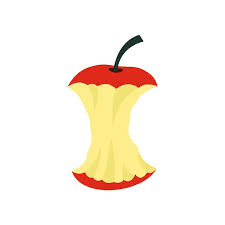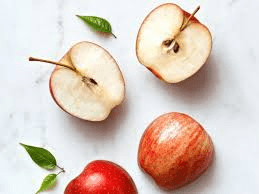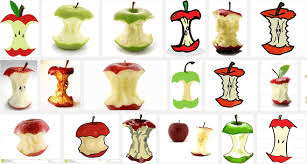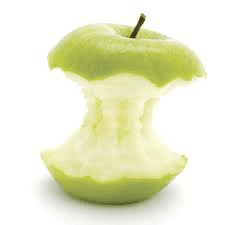Apple core refers to the central part of an apple, the fibrous region that contains the seeds. This structure, often discarded after the fruit is eaten, is an interesting subject from both a botanical and a nutritional perspective. The core of an apple is composed of several distinct parts: the seed cavity, the seeds themselves, and the surrounding tissue, known as the endocarp. This endocarp is the innermost layer of the pericarp, the part of the fruit formed from the ovary after flowering.
Botanically, an apple is a pome, a type of fruit produced by flowering plants in the subtribe Malinae of the family Rosaceae. The apple core is essentially the mature ovary of the flower, which has undergone significant changes post-fertilization.
The seeds within the core are the result of the fertilized ovules, and each seed is encased in a tough, protective outer coating. These seeds contain amygdalin, a compound that can release cyanide when metabolized, although the amount present in a typical apple seed is generally too small to be harmful when consumed in moderate quantities.
The apple core’s structure plays a crucial role in the development and dispersal of the seeds. The endocarp is designed to protect the seeds until they are ready to germinate. In nature, apples are often eaten by animals, which then help disperse the seeds through their droppings. This process aids in the propagation of apple trees. The tough endocarp ensures that the seeds pass through the digestive systems of animals unscathed.
From a nutritional standpoint, the apple core is similar to the flesh of the apple but is less commonly eaten due to its fibrous texture and the presence of seeds. The core contains dietary fiber, vitamins, and minerals, albeit in smaller quantities than the outer flesh. The fiber in the core can aid in digestion and contribute to overall gut health. Eating the entire apple, including the core, can provide more nutritional benefits, although care should be taken with the seeds due to the aforementioned amygdalin content.
The anatomy of the apple core is fascinating in its complexity. The central seed cavity is lined with a series of carpels, which are the compartments that house the seeds. The number of seeds in an apple core can vary, typically ranging from five to ten, depending on the type of apple and its growth conditions. Each carpel is separated by a membrane and filled with a gel-like substance that nourishes the developing seeds.
Scientifically, studying the apple core can provide insights into the broader field of plant reproductive biology. The development of the core from the ovary involves a series of intricate processes regulated by plant hormones and environmental factors. Understanding these processes can help in improving apple cultivation practices and developing new apple varieties with desirable traits such as disease resistance and improved nutritional content.
The apple core is a small but significant part of the apple, encompassing the seeds and the surrounding protective tissues. While often overlooked, it plays a vital role in the life cycle of the apple tree, from seed protection and dispersal to contributing to the fruit’s overall nutritional profile. Exploring the apple core reveals the intricate details of plant reproduction and the complex interplay of biological processes that give rise to one of the most popular fruits in the world.
The Economic Importance and Uses of Apple Core

1. Composting: Apple cores can be used in composting, enriching the soil with nutrients and reducing landfill waste.
2. Animal Feed: Apple cores can be fed to livestock such as pigs and goats, providing a nutritious supplement to their diet.
3. Pectin Production: Apple cores are a source of pectin, a natural thickening agent used in making jams, jellies, and other food products.
4. Vinegar Production: Fermenting apple cores can produce apple cider vinegar, which has various culinary and medicinal uses.
5. Natural Fertilizer: Decomposed apple cores can be used as natural fertilizer, promoting plant growth.
6. Biofuel: Apple cores can be converted into biofuel through fermentation processes, providing a renewable energy source.
7. Enzymes for Cleaning Products: Enzymes extracted from apple cores can be used in eco-friendly cleaning products.
8. Eco-Friendly Packaging: The fibers from apple cores can be used to create biodegradable packaging materials.
9. Craft Projects: Apple cores can be dried and used in various craft projects, such as decorations and ornaments.
10. Natural Dye: Apple cores can be used to produce natural dyes for fabrics and crafts.
11. Health Supplements: Apple cores contain vitamins and minerals that can be extracted for use in dietary supplements.
12. Flavoring Agent: Apple core extracts can be used as a natural flavoring in food and beverages.
13. Cosmetic Ingredients: Apple cores can be used in cosmetics for their antioxidant properties.
14. Animal Bedding: Dried apple cores can be used as bedding material for small animals.
15. Bioplastic Production: Apple core waste can be processed to create biodegradable plastics.
16. Biogas Production: Fermentation of apple cores can produce biogas, a renewable energy source.
17. Soil Conditioner: The fibrous material from apple cores can improve soil structure and fertility.
18. Educational Tools: Apple cores can be used in educational settings to teach about composting, recycling, and biology.
Read Also: The Type of Bird Recommended for Low Capital start up and the Quantity to Start with
The Products and By-products That Can Be Derived From Apple Core

1. Compost: Made from decomposed apple cores, enhancing soil fertility.
2. Animal Feed: Apple cores processed and used as feed for livestock.
3. Pectin: Extracted from apple cores, used as a gelling agent in food products.
4. Apple Cider Vinegar: Produced by fermenting apple cores, used in cooking and health remedies.
5. Biofuel: Ethanol produced from fermenting apple cores.
6. Cleaning Enzymes: Extracted enzymes used in eco-friendly cleaning products.
7. Biodegradable Packaging: Packaging materials made from apple core fibers.
8. Craft Materials: Dried apple cores used in various craft projects.
9. Natural Dye: Dye extracted from apple cores for fabrics.
10. Dietary Supplements: Extracted nutrients used in health supplements.
11. Flavor Extract: Natural flavoring agents derived from apple cores.
12. Cosmetic Additives: Antioxidant-rich extracts used in skincare products.
13. Animal Bedding: Dried cores used as bedding for small pets.
14. Bioplastic: Biodegradable plastic produced from apple core waste.
15. Biogas: Methane gas produced from fermenting apple cores.
16. Soil Conditioner: Fibrous material from cores improving soil quality.
17. Educational Demonstrations: Used in teaching about recycling and composting.
Read Also: What is some advantages of solar energy?
Frequently Asked Questions (FAQ’s) About Apple Core

1. What is an apple core?
The apple core is the central part of the apple, containing seeds and fibrous material.
2. Can apple cores be composted?
Yes, apple cores can be composted to create nutrient-rich soil.
3. Are apple cores safe for animals to eat?
Yes, apple cores can be fed to certain animals like pigs and goats, but the seeds should be removed as they contain cyanide.
4. How is pectin extracted from apple cores?
Pectin is extracted by boiling apple cores in water and then using an acid to precipitate the pectin.
5. What is the process of making apple cider vinegar from apple cores?
Apple cores are fermented with yeast and bacteria to produce apple cider vinegar.
6. Can apple cores be used to produce biofuel?
Yes, apple cores can be fermented to produce ethanol, a type of biofuel.
7. How can apple cores be used in cosmetics?
Extracts from apple cores can be used in skincare products for their antioxidant properties.
8. What are the benefits of using apple cores in animal feed?
Apple cores provide additional nutrients and fiber to animal diets.
9. Can apple cores be used as a natural dye?
Yes, apple cores can produce a natural dye for coloring fabrics.
10. Are there any industrial uses for apple cores?
Yes, apple cores can be used in producing bioplastics, biofuels, and biodegradable packaging.

